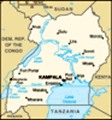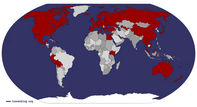Advertisement
Published: April 22nd 2009
In October 2008, I had an opportunity to visit Uganda as part of a team from Engineering Ministries International learning construction management techniques in East Africa. EMI provides planning, design, and construction management services free of charge to organizations who serve the poorest of the poor around the world. Facilities include hospitals and clinics, schools and orphanages, roads and water systems, etc.
I departed Denver early Monday morning, October 6, 2008, and after a few hour stopover in Amsterdam, arrived 30 hours later in Entebbe, the evening of Tuesday, October 7. I was amazed at the number of aid workers on the plane. I payed my $50 in new bills for a visa and checked through customs. As it was dark, I didn't see much of Uganda on the hour long drive to the guest house in Kampala.
The following morning, Wednesday, October 8, I woke early due to jet lag, and met the others on our team for breakfast. After breakfast we had an orientation meeting, where we reviewed customs in Uganda, and our itinerary. We then took a van to our first destination, Jinja. The Uganda countryside between Kampala and Jinja is lush. We passed through a
forest populated by bandits. We learned that at least this part of Uganda could grow sufficient food to feed the local population. We stopped along the way to buy food from crowds of vendors selling chicken on a stick and casava roots (tasted like baked potato)
We had Indian food for lunch, followed by a tour of Arise Africa International (see http://www.ariseafricaintl.org/) projects, including the reconstruction of an old theater to serve as a conference center. By mid afternoon, we headed to the site where they were starting the construction of a kitchen/dining facility for an orphanage. We would spend the next two days digging and pouring the footings for the foundation. We all settled into a single bunk room with eight bunks w/mosquito nets; but no electricity or running water. The multi-pit outhouse and bath facility was located about 200 meters up the hill from the bunk house; a fact that would cause some concern later that night. We had dinner in a thatched open sided dining area as the sun was setting. After dinner someone brought out their guitar, and we attempted to sing; but most of us were very tired from our long trip so we
turned in about 8 pm. Sometime in the middle of the night, I awoke from the load claps of thunder and flashes of lightning. I also realized that nature was calling me, and rather urgently because something I had eaten that day didn't agree with me. I really didn't want to trek up the mountain to the outhouse in the middle of a thunderstorm, with who knows what kind of wild animals lurked in the dark, with only a flashlight and no umbrella. Trying to hit the target of a squat toilet in daylight was difficult enough. Well, let's move on the the following morning.
Thursday, October 9, was our first construction day. We woke early, had breakfast, and then proceeded to the warehouse to collect our tools and building supplies. We loaded our wheel barrows with bricks and 110 pound sacks of cement and pushed them a half mile to the construction site. I wondered why they couldn't have located the storage building closer to the construction site...the first of many efficiency related questions I would have. We divided into teams; one for digging the trenches for the footings, one for cutting, bending, and placing the rebar, and
one for mixing and pouring concrete. I was on the concrete team with two other EMI team members and an African foreman and laborer. The idea was to rotate teams so that everyone had a chance to work on each task. Somehow, I ended up on the concrete team the whole time, although I did rest when total exhaustion overwhemed me, and consummed multiple bottles of warm water. The Africans, however, never seemed exhausted. Fortunately, the temperature never got above 90's, and we had plenty of suntan lotion, so never burned.
First, we constructed a brick platform and filled in the cracks between the bricks with sand. We then mixed the concrete on this platform, first spreading out five wheelbarrows full of crushed rock, then two wheelbarrows full of sand on the rock, and finally emptying a bag of cement on the sand. To meet the mix design of a 1-2-5 ratio, we really should have added an additonal half bag of cement, but cement is very expensive... Then the foreman began to add water, estimating the correct consistency. We didn't perform a slump test to confirm his estimate. We then used the wheel barrows to move and pour
the concrete mix into the trench. This was a continuous process until we reached a point where a construction joint could be placed.
I quickly learned some things about construction is East Africa. 1) Although a structural engineer has to sign off on the structural drawings, there are no inspectors to ensure that the construcion is done in accordance with the plans and specifications (note: later that week we read in the newspaper that a multistorey building in Kampala had collapsed). 2) Labor is cheap, so if something can be done with labor instead of machines, then it is done with labor. For example, all the crushed rock was produced by hand...someone with a hammer and chissel attacking a larger rock. I even saw a newly paved highway with the center line being painted by hand by a crew of ten.
We broke for lunch and then back to work, mixing and pouring. Another team helped to extend the brick platform, which doubled our capacity. However, without their additional manpower to meet that capacity, all this meant was that we didn't have any break time between mixing batches, as we immediately began to mix the next batch as
the first batch was being loaded on wheelbarrow for pouring the footings. Even before the end of the day, I was done in, which gave me a great opportunity to talk to some of the onlookers, and hand out candy to the many kids.
Before dinner we each bathed in our own fashion. Having been raised in Thailand, I was used to taking a full bath by using a bucket of water from which I would draw from using a cup and pouring the water over my body. After I was wet, I soaped and shampooed, and then used additional cups to rinse off. Total water consumed: about two gallons. Others, however, just rinsed off the upper parts of their bodies.
The main course of our evening meal was roast chicken, which I had seen alive earlier that day on the way to having their heads cut off. My daughter, Rosanna, is a vegatarian. I'm not. But having seen the chickens alive, somehow I couldn't bring myself to eat them. A thunderstorm arrived earlier that evening while we had dinner. We were all exhausted so had an early night.
Friday, October 10, we worked all morning, again
mixing and pouring concrete. We finished the footings by late morning, had lunch and then loaded everything into the van to head back to Jinja to see a retreat center built by a Dutch lady who had worked with street children for about 20 years before being shot by Didi Amin's soldiers in her arm, which she was holding up to protect the rest of her body. She realized that one of the greatest needs in Africa was for a retreat center where burned out aid workers could come to recouperate. We were there to see her plans for extending the retreat center to include a conference facility for young people. After a walking tour of the property we had lunch and then went to the Arise Africa guest home for that night. It was great to have a warm shower and good meal.
Saturday, October 11, we headed back to Kampala to another organization that meets the health needs of the elderly, Reach Out Touch One Ministries (ROTOM). Most developing countries do not have social security. The elderly are taken care of by their children. However, with the AIDS epidemic in Africa and Uganda (which is now under
control), almost an entire generation was wiped out leaving the elderly with no one to take care of them, and responsibility to take care of their children's children (hence the reason for so many orphans), when they were physically incapable of taking care of them. ROTOM provides medical care so that grandparents can take care of their grandchildren. We visting a site where the administration building was nearly complete. This building woudl also serve as a clinic until the clinic and hospice were built. We had lunch at a university; eating with lots of students. We then returned to the guest house in Kampala. That evening we walked the streets and ate street food. I had Rolex; sort for rolled eggs which is fried eggs wrapped in a chapati (an Indian flat bread).
Kampala is a large city spread over many hills. Consequently, the streets are not in any sort of grid pattern. Traffic is chaotic. Side streets are not paved and due to the rains, are full of pot holes. Sitting in the back seat of the van, I hurt my head several times on the ceiling as the van jounced over the pot holes. I was informed
that such streets are only graded every few years just before elections. Uganda was having elections later that year, but the pot hole filling had not happened yet.
Sunday, October 12, we attended Calvary Chapel in downtown Kampala, followed by lunch at the food court of their fanciest mall. It was great to have a ice cold milkshake after so much warm bottled water. We then went to a craft market and bought souveniers, followed by a tour of an international school and EMI's offices. Dinner was at a sandwich shop of a western grocery store.
Monday, October 13, we visited construction sites for Scripture Union Camp, on the shore of Lake Victoria, and then a school/orphanage for the African Children's Choir, where we had lunch (see picture). Before heading back to Kampala, we dropped off two members of our team at Entebbe Airport, who were headed to Nairobi, Kenya to participate in a design project for a hospital.
Tuesday, October 14, we again headed in the direction of Entebbe, this time visiting construction projects at the Westminster Seminary and the Entebbe Calvary Chapel School. We learned that the property where the school was located on the
banks of Lake Victoria was a killing field used by Didi Amin's soldiers. We were pleased with the new use of this land. We ate dinner at a nice restaurant, where I finally had some Italian food, before dropping off additional team members at the airport. Three of us would remain behind to go on safari the following morning; the subject of my next blog, as this one is already long enough.
Advertisement
Tot: 0.076s; Tpl: 0.016s; cc: 12; qc: 32; dbt: 0.0379s; 1; m:domysql w:travelblog (10.17.0.13); sld: 1;
; mem: 1.2mb






















john nviiri
non-member comment
Engplan consultants limited
How can our team be part of your projects